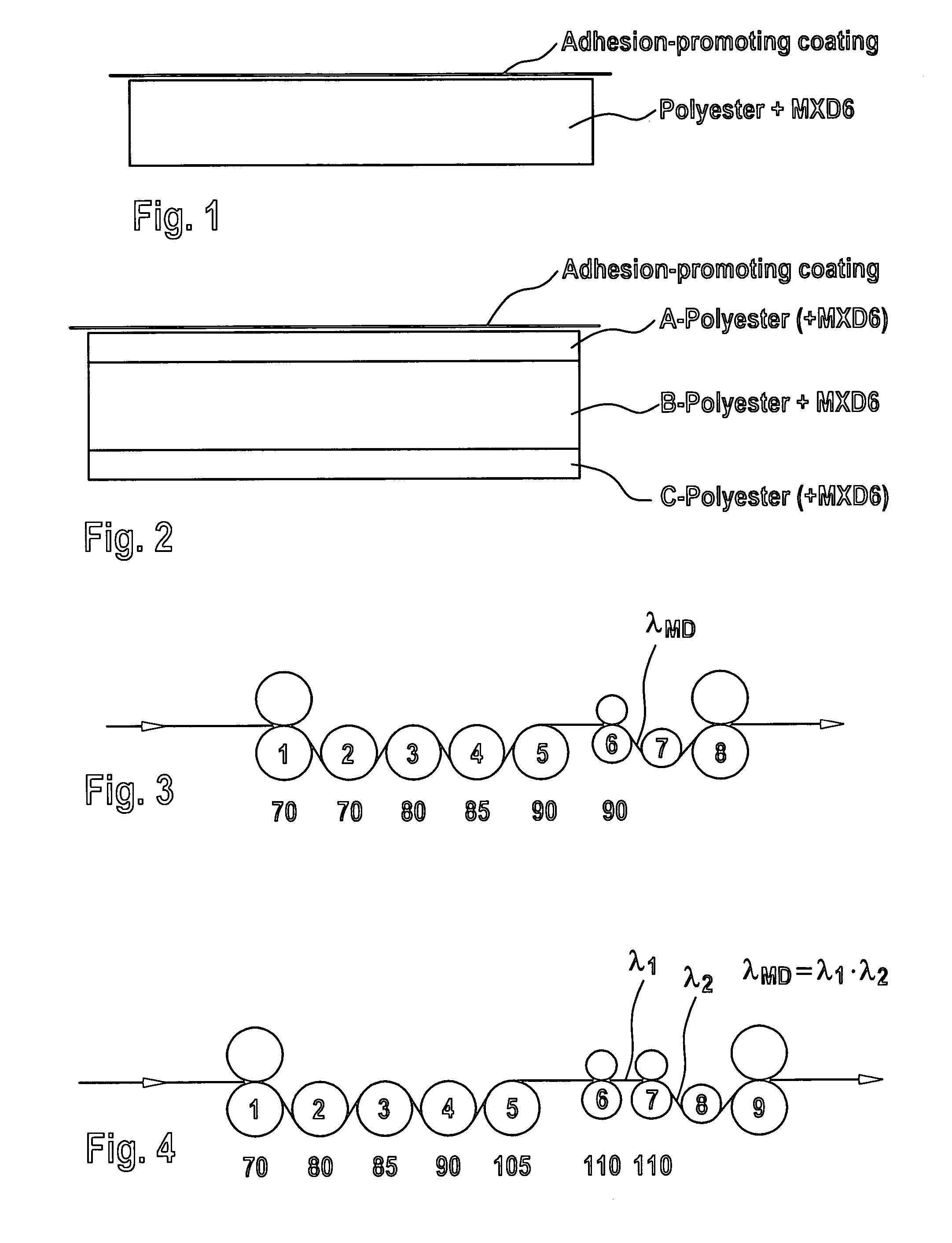Extrusion-coatable polyester film comprising poly(m-xyleneadipamide)
a polyester film and extrusion coating technology, applied in the direction of water-setting substance layered product, synthetic resin layered product, packaging, etc., can solve the problems of high cost of additional machinery, yield loss, and unreceptive pet surface to extrusion coating with polyolefins, and achieve excellent barrier properties and excellent suitability for metallizing or vacuum coating
- Summary
- Abstract
- Description
- Claims
- Application Information
AI Technical Summary
Benefits of technology
Problems solved by technology
Method used
Image
Examples
example 1
[0130]N-2-(aminoethyl)-3-aminopropyltrimethoxysilane (AEAPTMS) (supplied as Z-6020 from Dow Corning and as A-1120 from Union Carbide) was dispersed at a concentration of 2.0% by weight in normal tap water. To promote the hydrolysis process here, acetic acid was added at a concentration of 0.2% by weight.
[0131]Alongside this, chips comprised of polyethylene terephthalate (prepared by way of the transesterification process using Mn as transesterification catalyst, Mn concentration in polymer: 100 ppm, dried at a temperature of 150° C. to a residual moisture level below 100 ppm, and poly(m-xyleneadipamide) (MXD6), likewise dried at a temperature of 150° C. were introduced in a mixing ratio of 90:10 into the extruder (twin-screw extruder with two vents), and a single-layer film was extruded.
[0132]
Film structure10% by weightpoly(m-xyleneadipamide) (MXD6) from MitsubishiGas Chemical Co., product name NYLON ® MXD66007, with melt viscosity of 5000 poise80% by weightpolyethylene terephthalat...
example 2
[0140]As in Example 1, N-2-(aminoethyl)-3-aminopropyltrimethoxysilane was dispersed at a concentration of 2.0% by weight in normal tap water. This example therefore used the adhesion-promoting layer of Example 1.
[0141]Chips comprised of a copolyester comprised of terephthalate units and of isophthalate units, and of ethylene glcyol units (the proportion of ethylene terephthalate being 90 mol % and the proportion of ethylene isophthalate being 10 mol %, prepared by way of the transesterification process using Mn as transesterification catalyst, Mn concentration in polymer: 100 ppm; dried at a temperature of 100° C. to a residual moisture level below 100 ppm) and poly(m-xyleneadipamide) (MXD6), likewise dried at a temperature of 100° C., were introduced in a mixing ratio of 90:10 into the extruder (twin-screw extruder), and a single-layer film was extruded. The film was oriented longitudinally (in two stages) and transversely, the product being a transparent film with total thickness ...
example 3
[0149]The mixing ratio of MXD6 and polyethylene terephthalate was changed from that of Example 1. In this Example, chips comprised of polyethylene terephthalate and poly(m-xyleneadipamide) (MXD6, dried) were introduced in a mixing ratio of 85:15 into the extruder (twin-screw extruder), and a single-layer film was extruded. The film was oriented longitudinally (in two stages) and transversely, the product being a transparent film with total thickness 12 μm.
[0150]
Film structure15% by weightpoly(m-xyleneadipamide) (MXD6) from MitsubishiGas Chemical Co., product name NYLON ® MXD66007, with melt viscosity of 5000 poise75% by weightpolyethylene terephthalate 4023 from KoSa,Germany, with SV 80010% by weightpolyester from KoSa with SV 800, comprised of99% by weight of polyethylene terephthalate4023 from KoSa and 1.0% by weight of silicaparticles (SYLYSIA ® 320 from Fuji, Japan) withd50 2.5 μm.
[0151]The production conditions in the individual steps of the process are as follows:
[0152]
Extrusi...
PUM
| Property | Measurement | Unit |
|---|---|---|
| melt viscosity | aaaaa | aaaaa |
| thickness | aaaaa | aaaaa |
| haze | aaaaa | aaaaa |
Abstract
Description
Claims
Application Information
 Login to view more
Login to view more - R&D Engineer
- R&D Manager
- IP Professional
- Industry Leading Data Capabilities
- Powerful AI technology
- Patent DNA Extraction
Browse by: Latest US Patents, China's latest patents, Technical Efficacy Thesaurus, Application Domain, Technology Topic.
© 2024 PatSnap. All rights reserved.Legal|Privacy policy|Modern Slavery Act Transparency Statement|Sitemap


